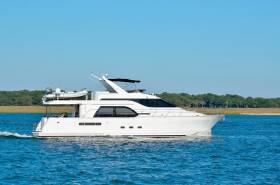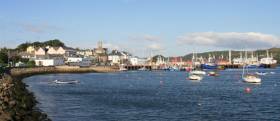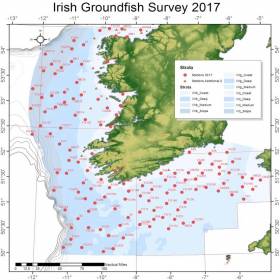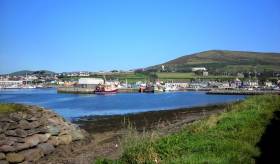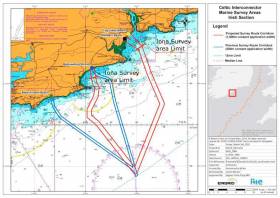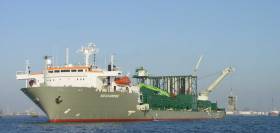Displaying items by tag: Marine Notice
Cruising To Europe? Be Sure To Have An International Certificate for Operators of Pleasure Craft
#Cruising - The Department of Transport, Tourism and Sport (DTTAS) wishes to draw attention to the fact that some European Union member states require the operators of pleasure craft operating within their territorial waters to hold an International Certificate for Operators of Pleasure Craft (ICC).
Irish Sailing, which supersedes Marine Notice No 12 of 2011, Resolution No. 40 (as amended by Resolution No. 71) of the Inland Transport Committee of the United Nations Economic Commission for Europe (UNECE) outlines the requirements for the issue of the ICC.
Resolution No. 40 also lists the countries that have notified the UNECE Secretariat that they have accepted the Resolution.
An ICC issued by a government that has accepted Resolution No. 40 indicates that the ICC holder has demonstrated the level of competence required by Resolution No. 40 for the ICC to be issued.
Irish Sailing is appointed as an approved body to issue the ICC on behalf of the DTTAS. Persons requiring an ICC should contact Irish Sailing.
Marine Notice: Irish Anglerfish and Megrim Survey 2018 Off West, Southwest and South Coasts
#IAMS2018 - The annual Irish Anglerfish and Megrim Survey for 2018 (IAMS 2018) will be carried out between Monday 19 February and Monday 19 March off the West, Southwest and South Coasts of Ireland, in fulfilment of Ireland’s Common Fisheries Policy (CFP) obligations.
The IAMS is a demersal trawl and beam trawl survey consisting of approximately 85 otter trawls (60 minutes) and 25 beam trawls (30 minutes) in International Council for Exploration of the Sea (ICES) area 7b, 7c, 7g, 7h, 7j and 7k. Fishing in 2018 will take place within a 3 nautical mile (nmi) radius of these indicative positions.
The survey will be conducted by the RV Celtic Explorer (Callsign EIGB), which will display all appropriate lights and signals and will also be listening on VHF Channel 16 for CE18004. The vessel will be towing a Jackson demersal trawl or two four metre wide beam trawls during operations.
The Marine Institute requests that commercial fishing and other marine operators to keep a 3nmi area around the tow points clear of any gear or apparatus during the survey period.
While there is no statutory provision for the loss of gear at sea, the Marine Institute will make every effort to avoid gear adequately marked, according to legislation, that may be encountered in the notified areas.
In the event that an operator has static gear or other obstructions within 3nmi of the listed points, it is the responsibility of the owner to notify the survey managers or vessel directly.
This should be communicated by identifying specifically which ‘station’ is of concern using the appendix and contact details provided in Marine Notice No 03 of 2018, a PDF of which is available to read or download HERE.
Marine Notice: Cable Route Survey Off North-West Coast
#MarineNotice - Fugro will be carrying out marine operations on behalf of TE Subsea Communications LLC for the HAVFRUE Subsea Cable System Project from this weekend.
The survey project is scheduled to begin on Saturday 20 January and last for around 14 days, weather permitting, as conducted by the MV Fugro Discovery (Callsign 3EKE6).
Survey operations will be conducted on a 24-hour basis. Throughout, the vessel will be displaying the shapes and lights prescribed in the International Rules for the Prevention of Collisions at Sea (COLREGS) Rule 27, to indicate that the survey vessel is restricted in its ability to manoeuvre.
A listening watch will be maintained on VHF Channel 16, and the vessel will actively transmit an AIS signal.
The survey comprises a dynamic programme to be conducted in several stages. The survey vessel will be deployed within the working area at times and positions determined by client requirements, weather and sea conditions.
Co-ordinates of the survey area are included in Marine Notice No 02 of 2018, a PDF of which is available to read or download HERE. Please note that the survey within Irish territorial waters as indicated is not part of this notice and will be undertaken at a later date under separate notification.
#DLHarbour - Dun Laoghaire Harbour Company has issued its first notices to mariners for 2018, superseding all previous marine notices.
Regarding fairway priorities, the harbour fairways and approaches are generally to be kept clear and free. It is prohibited to anchor or lay moorings in these areas as marked on navigational publications and charts.
No race marks, buoys, floats, etc are to be laid in the fairways or the near approaches to Dun Laoghaire Harbour – and no racing shall take place other than by specific written permission from the Harbour Master.
Any lobster/crab pots that are laid shall remain clear of all harbour navigational waters, and slipways.
Large power-driven vessels (cruise liners, ferries, lighthouse and Naval Service vessels) and smaller power-driven vessels with restricted manoeuvrability (such as cruise ship tenders and small passenger ferries) have priority over all other craft, including the area of the harbour limits that extend 600 metres seaward of the harbour mouth.
Large power-driven vessels are to sound a prolonged blast when approaching the harbour mouth from either direction, or the appropriate signal when manoeuvring off, departing or preparing to depart from their berths.
A vessel may also sound a preliminary, prolonged blast, just prior to departure, so as to alert other harbour users of its imminent departure.
Irrespective as to whether or not any such signal is sounded, the obligation remains for small craft togive priority to the large power-driven vessels.
Regarding VHF reporting, all vessels, excluding pleasure craft, are required to call ‘Harbour Office Dun Laoghaire’ on VHF Channel 14 as follows:
- ETA at harbour entrance at least two hours in advance, and for any scheduled ferries call at least half an hour in advance.
- ETD at least one hour in advance, followed by confirmation five minutes prior to departure.
Unscheduled arrivals should call ‘Harbour Office Dun Laoghaire’ on mobile +353 83 144 3412 (24hr) at least two hours before arrival.
Works At Killybegs Fishery Harbour Centre Till March
#MarineNotice - The Marine Engineering Division of the Department of Agriculture, Food and the Marine is undertaking dredging works at Smooth Point in Killybegs Fishery Harbour Centre from this month till March 2018.
Plant on site shall include the backhoe dredger Capall Mara (Callsign IJFN2) as well as modular pontoon flat top dredge barges, tugs and other smaller vessels.
The Department of Agriculture, Food and the Marine is also undertaking works at the east side of the Auction Hall/Landing Pier involving the installation of additional steel fendering along the face of the pier and the construction of mooring dolphins at the start of the pier.
These works shall involve the use of heavy civil engineering drilling and lifting plant. There will be a jack-up barge and a spud barge on-site during the works. Divers shall also be employed at the beginning and at the end of the project.
For safety reasons mariners are requested to stay clear of these sites during the works in the harbour and are requested to proceed with caution in the area of the new pier and the Auction Hall/Landing Pier. Wave wash from vessels should be avoided.
Further details of these works are included in Marine Notice No 58 of 2017, a PDF of which is available to read or download HERE.
Groundfish Survey Off South & West Coasts Ongoing Till December
#MarineNotice - The Marine Institute advises that the annual Irish Groundfish Survey (IGFS2017) is being carried out off the South and West coasts of Ireland till Saturday 9 December in fulfilment of Ireland's Common Fisheries Policy obligations.
The IGFS is a demersal trawl survey consisting of approximately 125 fishing hauls of 30 min duration each in ICES area VIIb, VIIg and VIIj.
Fishing in 2017 is taking place within a two nautical mile radius of these indicative positions, the approximate locations of which are noted in Marine Notice No 55 of 2017.
As with last month's survey off the North West, the operation is being conducted by the RV Celtic Explorer (Callsign EIGB).
The vessel is displaying all appropriate lights and signals during the survey and is also listening on VHF Channel 16. It is towing a high headline GOV 36/47 demersal trawl during fishing operations.
Commercial fishing and other marine operators are requested keep a two nautical mile area around the tow points clear of any gear or apparatus during the survey period.
Dredging Works At Dingle Fishery Harbour Centre
#MarineNotice - Dredging works were set to commence this week at Dingle Fishery Harbour Centre and are expected to be ongoing until the end of February 2018.
The works will involve the dredging of the north/south section of the main navigation channel and an area between the breakwaters off the main quay head.
The vessel Grete Fighter (Callsign: OZLP2) and the jack-up barge Yo Yo will be onsite and will maintain a VHF watch on Channel 16/14.
Three Special Mark (monitoring buoy) Fl Y 2s will be in positions 150 meters east, west and south of the north/south channel within the fishery harbour centre.
The Grete Fighter will be transiting to an approved dumpsite east of Beenban Head marked by four special marks.
Port hand marks and leading lights will be affected during the course of the works.
For safety reasons, mariners are requested to proceed slowly and with caution when in the vicinity of the dredging vessels in the fishery harbour centre and to give the works a wide berth.
Contact details and co-ordinates of the dump area are included in Marine Notice No 53 of 2017, a PDF of which is available to read or download HERE.
Marine Notice: Monitoring Buoy Deployment In Killybegs Bay
#MarineNotice - TechWorks Marine advises that it is planning to deploy a marine monitoring buoy in Killybegs Bay that will be in place from this month till March 2018.
Part of the oceanographic monitoring for the Department of Agriculture, Food and the Marine, the buoy will be deployed on a dual mooring from the vessel Sinbad (Callsign EI7799).
The buoy will remain on site for a period of up to five months, after which it will be retrieved by a chartered vessel and the retrieval team.
A Sealight installed on the buoy which will give out five yellow flashes every 20 seconds. The light is visible for up to three nautical miles.
The buoy has a Special Mark as well as a small marker buoy indicating the location of each of the buoy’s moorings.
During the extent of deployment, vessel traffic will need to avoid the area. For both deployment and recovery the VHF channels monitored will be Channel 14 (Killybegs Harbour working channel) and Channel 16.
Details of the deployment are included in Marine Notice No 52 of 2017, a PDF of which is available to read or download HERE.
#MarineNotice - The survey vessel Kommandor Iona is conducting offshore survey operations associated with the proposed Celtic Interconnector, on behalf of EirGrid.
As with last month’s nearshore survey, the current works are in two main corridors to three landfall points off the South Coast of Ireland, namely Ballinwilling Strand, Redbarn Beach, Claycastle Beach.
The Kommandor Iona (Callsign: GAAK) was scheduled to begin operating on a 24-hour daily basis since this Tuesday (24 October) for approximately a week’s duration, collecting geophysical data utilising vessel mounted sensors and towed sonar extending up to 200m from the vessel.
The survey will be conducted under Foreshore Licence FS006722 in the deeper waters offshore from the Iona survey area limits.
Survey activities will extend no more than 35km from the shoreline within a 500m area or corridor centred on the co-ordinates listed in Marine Notice No 47 of 2017, a PDF of which is available to read or download HERE.
Those engaged in fishing are respectfully asked not to leave any static fishing equipment within a distance of 250 metres of the proposed survey route centre lines as detailed in the route position list, and skippers are advised to withdraw and keep beyond a safe distance (1 nautical mile) from survey vessels.
#MarineNotice - PSE Kinsale Energy Limited advises that rock placement works will take place with an associated survey on the Kinsale Head Gas Export Pipeline off the South West Coast of Ireland from today (Wednesday 11 October).
The objective of these works is to stabilise two areas of the export pipeline. The works are expected to last for nine days.
Works will be carried out by the fallpipe rock placement vessel Seahorse (Callsign PCAP). The vessel will have a fallpipe deployed close to the seabed. Regular safety messages will be broadcast on VHF Channel 16.
All vessels, particularly those engaged in fishing, are requested to give the Seahorse a wide berth and keep a sharp lookout in the relevant areas. In case of any doubt, call the Seahorse on VHF Channel 16 and a safe course to follow will be given.
Full details of the work area are included in Marine Notice No 44 of 2017, a PDF of which is available to read or download HERE.


























